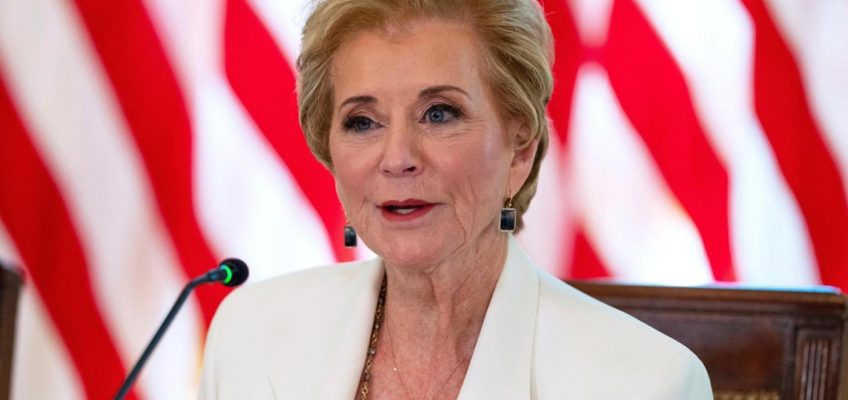By COLLIN BINKLEY, AP Education Writer
WASHINGTON (AP) — The U.S. Education Department is handing off some of its biggest grant programs to other federal agencies as the Trump administration accelerates its plan to shut down the department.
Related Articles
Foreign enrollment at US colleges holds steady, for now, despite Trump’s visa crackdown
Tribal college leaders are uneasy about US financial commitments despite a funding increase
Judge indefinitely bars Trump from fining University of California over alleged discrimination
Critics warn Florida’s new teaching standards rehabilitate aspects of the anti-communist Red Scare
Can federal immigration agents go in schools? Here’s what to know.
It represents a major step forward for the administration’s dismantling of the department, which has mainly involved cutting jobs since President Donald Trump called for its elimination with an executive action in March.
Six new agreements signed by the Education Department will effectively move billions of dollars in grant programs to other agencies. Most notable is one that will put the Department of Labor over some of the largest federal funding streams for K-12 schools, including Title I money for schools serving low-income communities.
Department officials said the programs will continue to be funded at levels set by Congress. They did not say whether the changes would bring further job cuts at the department, which has been thinned by waves of mass layoffs and voluntary retirement offers.
“The Trump Administration is taking bold action to break up the federal education bureaucracy and return education to the states,” Education Secretary Linda McMahon said in a statement. “Cutting through layers of red tape in Washington is one essential piece of our final mission.”
The action leaves in place the Education Department’s $1.6 trillion student loan portfolio and its funding for students with disabilities, though McMahon has suggested both would be better managed by other federal departments.
McMahon and her staff have spent months hammering out the deals, which allow the department to lop off large parts of its footprint without action from Congress. It’s being done through formal agreements that agencies often make with one another when their work overlaps.
The Education Department tested the idea in June with a deal that moved adult education programs to Labor. The new agreements take it a step further and lay the groundwork for more.
Officials say the new agreements provide a “proof of concept” as the administration works to persuade Congress to close the agency. The goal is to convince Congress that the deals should be cemented into legislation, eliminating a need for the department.
Under the new plan, Labor will oversee almost all grant programs that are now managed by the Education Department’s offices for K-12 and higher education. Along with the $18 billion Title I program, that includes smaller funding pools for teacher training, English instruction and TRIO, a program that helps steer low-income students to college degrees.
It will effectively outsource the department’s Office of Elementary and Secondary Education and Office of Postsecondary Education, two of the agency’s largest units. Two major roles of the postsecondary office will remain with the Education Department: oversight of student loan policy and the accreditation of colleges for eligibility to receive students’ federal financial aid.
States and schools should not expect any disruptions in their funding, the department said, but their federal money will now come from the Department of Labor.
Another deal will put Health and Human Services in charge of a grant program for parents who are attending college, along with management of foreign medical school accreditation. The State Department will take on foreign language programs. Interior will oversee programs for Native American education.
Opponents have urged against such a shake-up, saying it could disrupt programs that support some of the nation’s most vulnerable student populations. Some argue that other agencies don’t have the expertise that schools and families rely on at the Education Department. Some also question the plan’s legality, noting that legislation requires the Education Department to oversee some of its operations in-house.
Department officials say their plan is legally sound and argue it will make programs more efficient.
McMahon has increasingly pointed to what she sees as failures of the department as she argues for its demise. In its 45 years, she says it has become a bloated bureaucracy while student outcomes continue to lag behind. She points to math and reading scores for the country’s K-12 students, which plummeted in the wake of pandemic restrictions.
Her vision would abolish the Education Department and give states wider flexibility in how they spend money that’s now earmarked for specific purposes, including literacy and education for homeless students. That, however, would require approval from Congress. The task is complicated by the fact that some of the department’s core work has long had bipartisan support.
The new deals are part of a broader plan to prove that America’s schools and colleges can operate without the department. As part of the plan, officials say McMahon will continue touring the country to highlight the successes of local schools — and she will also spend more time making her pitch to lawmakers on Capitol Hill.
The Associated Press’ education coverage receives financial support from multiple private foundations. AP is solely responsible for all content. Find AP’s standards for working with philanthropies, a list of supporters and funded coverage areas at AP.org.


Leave a Reply